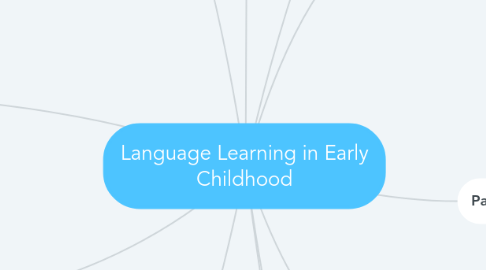
1. The School years
1.1. Reading
1.1.1. metalinguistic awareness: seeing words represented by letters or symbols. Language has a form AND a meaning
1.2. Multiple meanings for the same words
1.3. Different language acquisition registers.
1.4. Different language to speak to different people (principal vs friends)
1.5. word puzzles: Familiar language used in unfamiliar ways, meaning and words are interchangaeable
2. The Behaviorist perspective
2.1. behaviourism
2.1.1. B.F. Skinner (1957)
2.2. Children imitate what they hear, and when they are positively reinforced they will reproduce the sounds again.
2.3. imitation and practice as the primary processes in language development
3. The Innatist perspective
3.1. Noam Chomsky: all human languages are based on some innate universal principles
3.2. argues that children are biologically programmed for language and language develops in the child just like biological functions
3.3. Children's minds are NOT BLANK SLATES
3.4. Children are BORN with ability to discover language
4. Interactionist/developmental perspectives
4.1. language acquisition is similar to other cognitive skills. Interaction leads to learning the language.
5. First Language Acquisition
5.1. How Do children do this?
5.2. What enables children to put together meaningingful sentnces?
5.3. How do Bilingual children acquire more than one language?
5.4. we know the what? we want to know the How?
6. The First three years (Milestones and developmental sequences
6.1. developmental sequences
6.1.1. predictable patterns in the emergence and development of first language/ similarities in first language acquisition all over the world
6.1.2. By the end of first year most babies understand a few frequently repeated words in the language(s) spoken around them.
6.1.3. 12 months: most babies can produce 1/2 recognizable words. 2 years: (most) 50 or more words @2 start combining words together "mommy juice".
6.2. auditory discrimination
6.2.1. babies who hear the same sounds become familiar with them and can distinguish them apart from similar sounds "Pa" and "ba"
6.2.2. babies who regularly hear more than one language continue to respond to differences in sounds for a longer period of time
6.3. Gramatical morphenes
6.3.1. order of acquisition
6.3.1.1. a developmental sequence
6.4. Negation
6.4.1. Comment on disappearance of objects, refuse a suggestion, reject an assertion "No"
7. The pre-school years
7.1. 4+ can ask questions, give commands, report real events, create imaginary stories, with correct word order and grammar. Know basic structure already, just need to learn more complex vocabulary.
7.2. learn several words a day
7.3. metalinguistic awareness
7.3.1. The ability to treat language as an object separate from the meaning it conveys
7.4. thousands of hours interacting with language
7.5. order of events may be mixed up
8. Patterns in Language
8.1. rules of word formation
9. the Critical Period Hypothesis
9.1. animals, including humans are genetically programmed to acquire certain kinds of knowledge and skill at specific times
9.2. Children not given access to language in infancy and early childhood will never acquire language if deprivation is too long
10. Piaget and Vygotsky
10.1. Jean Piaget (1951)
10.1.1. Language represent knowledge from interaction with environment
10.2. Lev Vygotsky (1978)
10.2.1. Zone of Proximal development
10.2.2. thought is internal speech
10.2.3. scaffolding
11. Bilingualism
11.1. More than one language in environment
11.2. additive bilingualism
11.2.1. maintenance of home language while second language is being learned

